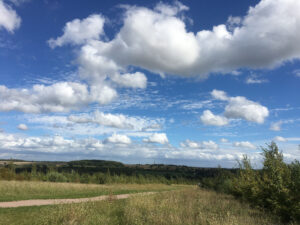At the beginning of September, I finally ventured out despite Covid-19 and visited Heartwood Forest with my wife and a friend. I have been a member of the Woodland Trust for maybe a decade and an half, but have never visited one of their sites. However, Heartwood Forest is owned, developed and managed by the charity, so I have finally broken my duck.

Wikipedia describes the charity as follows:
The Woodland Trust is the largest woodland conservation charity in the United Kingdom concerned with the creation, protection, and restoration of native woodland heritage. It has planted over 43 million trees since 1972.”
Heartwood Forest is a 347-hectare (858-acre) site, which was previously agricultural land. As a measure of its success as a new forest, it is now so big that it’s now the largest continuous new native forest in England.


Apparently, thousands of volunteers have planted more than 600,00 trees.

However, It is not simply new woodland, as the forest also has pockets of ancient bluebell woodland, old hedgerows, wildflower meadows and open grassland.

There is a network of paths, including a public footpath and two bridleways, run in and around Heartwood Forest, as well as through the existing ancient bluebell woodlands. In fact, there are three way-marked trails which take you to different areas of Heartwood Forest and you can download a PDF of the Heartwood Forest walking map here.
In fact Heartwood Forest is made up of four woods:
- Langley Wood.
- Pismire Spring.
- Well and Pudler’s Wood.
- Round Wood.
In spring, is possible to enter these ancient woods to see carpets of bluebells. In summer, mature broadleaf trees provide dappled shade for unique plants and wildlife.
Our visit
When I visited, we parked at what was a large car park (see also below), next to some interesting information boards.


We chose one of the simple walks and set off to find somewhere to have a picnic.
It became immediately obvious that there were big vistas everywhere and, in fact, not all is forest. There are huge areas of wildflower meadows, that were impressive when we were there at the beginning of Autumn, so must be superb at their peak.





There is also a small lake and horses being ridden everywhere. We started on one walk, but quickly started to chop and change, as the walks are connected and only a basic sense of direction is necessary.

One rather charming thing is the number of carved, wooden sculptures.



Other things to do
Apparently, another recent addition to Heartwood Forest is the arboretum, containing examples of all 60 of the UK’s native tree species. However, we didn’t get a chance to visit this. Definitely one for next year…
| Location |
| Heartwood Forest is close to St Albans, Hertfordshire, on either side of the B651 between Sandridge and Wheathampstead Village. At 858 acres, there are multiple entrances to the site, all linking to either bridleways, or public or permissive footpaths. |
| Car park |
| The free car park at Heartwood Forest provides parking for 55 cars, with five designated for blue badge holders. There are no time restrictions on length of parking for visitors. Eight bicycle stands are available, located in front of the visitor welcome and information point. |


